Do You Know... that chemicals and pesticides
used in agriculture can be hazardous? Pesticides
can be dangerous if you are working in fields that have been treated or sprayed with
them or when handling and
applying them. Pesticides can enter your body in many ways. Simple contact through skin and
clothes is one of the main ways chemicals enter your body. Another way is
through breathing mist, dust,
fumes, or smoke containing pesticides and chemicals. You can even poison
yourself if you don't wash your hands before eating.
|
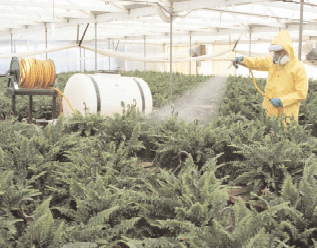
|
The EPA estimates that 10,000-20,000 physician-diagnosed pesticide
poisonings occur each year among the approximately 3,380,000 agricultural
workers in the United States. |
|
| Teen Safety Solutions |
Employers have the primary responsibility for
protecting the safety and health of their workers. Employees are responsible for
following the safe work practices of their employers.
|
- Be aware that chemicals may be on
or in plants, soil, irrigation water, or air drifting from
nearby applications.
- Be aware that your employer must train
you within six days of beginning work in areas where a chemical
application is taking place. Training is required for all
workers and handlers.
- Be aware that your employer must
notify you about areas where chemicals
are applied so you can avoid exposure, including:
- Pesticide product and its active ingredients.
- The method of application.
- The restricted entry interval (REI).
- You can prevent pesticides from
entering your body by:
- Following directions and signs about keeping out of restricted areas.
- Washing before eating, drinking, using chewing gum or tobacco, or using the toilet.
|
- Wearing proper work clothes that protect your body from chemical residues.
- Showering after work (including washing your hair) and putting on clean clothes.
- Washing your work clothes separately from other clothing.
- Washing immediately in clean water if pesticides are sprayed or spilled on you.
- Not touching your eyes, nose, or mouth with your hands if
they might be contaminated with chemicals.
|
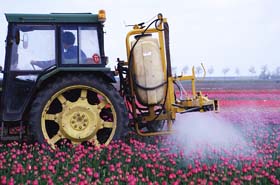
|
- Make sure you know where to wash off
and be decontaminated if you are exposed. Your employer must provide an area where you can wash off.
- Pesticides are classified for either
general or restricted use. Anyone can use a pesticide
labeled general, but those labeled restricted must be handled by a certified person. If you are under 16, you
cannot handle any pesticides, pesticide containers, or decontaminating equipment.
- Minimum protection when working with
pesticides is long sleeves, long pants, shoes, and socks, rubber
gloves, and splash-proof eye protection, regardless of the toxicity level of the pesticide.
|
|
| Employer Safety Solutions |
Employers have the primary responsibility for
protecting the safety and health of their workers. Employees are responsible for
following the safe work practices of their employers.
|
Follow the Fair Labor Standards Act (FLSA)
including:
|

|
- Some agricultural jobs are too dangerous for anyone under 16 to perform. No
youth under 16 years of age may be employed at any time in any
of these Hazardous Occupations in Agriculture
(HO/A); including
operating or helping to operate, starting, stopping, adjusting, feeding or any other activity involving physical
contact with the following machines:
|
|
|
- HO/A #9,
Handling or applying
agricultural chemicals if the chemicals are classified under the
Federal Insecticide, Fungicide and Rodenticide Act as Toxicity
Category I - identified by the word "Danger" and/or
"Poison" with skull and crossbones; or Toxicity
Category II - identified by the word "Warning" on the
label. (Handling includes cleaning or decontaminating
equipment, disposing of or returning empty containers, or
serving as a flagman for aircraft applying agricultural
chemicals.)
|
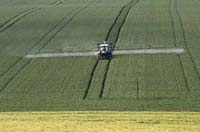 |
|
|
- HO/A #11, Transporting,
transferring, moving, or applying anhydrous ammonia (dry
fertilizer).
- Some exemptions will apply.
|
Follow EPA and OSHA Standards including:
- Employers must provide the following training as specified by the Environmental Protection
Agency [EPA 170.130]:
|
- Post
warning
signs to warn agricultural workers in advance about
pesticide applications. Warning signs must be in English and
either Spanish or an alternate language spoken by the workers.
- Restricted-Entry Interval (REIs):
Employers must ensure that all employees abide by these
intervals, which are found on the product label. REIs range from 12 to 48 hours.
[EPA 170.112]
- Notification: To prevent inadvertent
exposure, employers are required to warn workers about
pesticide-treated areas. Notification can be verbal or via
signs. If highly toxic chemicals are used, notification must be
both verbal and via signs. [EPA 170.224]
|
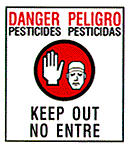
Warning signs must be posted in advance.
|
- Decontamination: Employees
must be provided with water for washing off splashed or spilled
pesticides or for general washing when they are finished working. [EPA 170.150]
- Medical Emergencies:
In emergencies, employers are responsible for providing the following
[EPA 170.160]:
- The name and location of the nearest medical facility.
- Transportation to a medical facility.
- Information about the pesticide(s) involved in the accident.
|
- PPE: Pesticide
handlers must wear the personal protective equipment (PPE)
specified on the pesticide container label. Employer's
responsibilities include [EPA
170.112]:
- Providing PPE to each worker.
- Cleaning and maintaining PPE.
- Ensuring that each worker wears and uses PPE correctly.
- Preventing heat stress if the work and PPE could cause it.
|
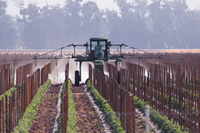
|
- Implement a written program that meets the
requirements of the OSHA Hazard
Communication Standard to provide for worker training,
warning labels, and access to Material Safety Data Sheets (MSDS).
- Ensure that workers are protected
against cadmium exposure as specified in 29 CFR 1910.1027,
including providing PPE if necessary. Cadmium is an
element found in phosphate fertilizers and the handling and
application of such fertilizers may expose workers to unsafe
levels of cadmium.
|
Consider implementing
recommended safe work practices, including:
- Develop a "safety first" attitude. Follow safe work practices all the time and set a good
example for others.
- Train all workers in emergency procedures and be able to recognize symptoms of chemical poisoning.
- Develop an emergency plan and train workers what to do in case of a spill, fire, or other emergency.
|
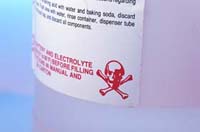
|
|
|
Additional Information:
|
|

